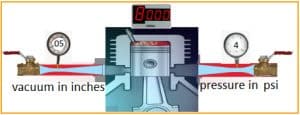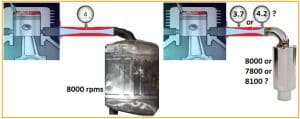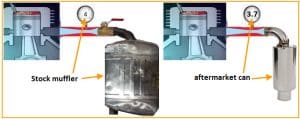Advice is at the bottom in the “logic statement”
04-05: To tune your clutches you have to know where the power band of your engine is.
04-06: When the engine has been modified, it is important that you know how the power curve has been changed to so that you can tune to the new power peak.
04-07: Any internal combustion engine is an air pump, and the amount of power you obtain is directly proportional to the weight of air and gas you can burn in a given time.
The density of the air has a direct effect on the power output. Air density is controlled by pressure, temperature and humidity. Pressure and temperature have the largest influence on your power.
04-08: Know your power curve and its limitations when you work on your clutch.
04-09: Your job as a clutch tuner is to the match the clutch to your engine curve and obtain the best possible performance of the conditions your vehicle is experiencing.
139 Air Pump The engine block, enough said.
Suction On the intake side of the engine, underneath the piston, the low pressure (vacuum) is created in the crankcase. That low pressure (vacuum) draws air through the stream of your airbox tract. That air going through the airbox is forced from outside atmospheric pressure through a one way check valve into the crankcase. You can think of it as; the whole air intake system from the hood inlet to the underside of the piston skirt is – “a tuned port with a valve”.
Discharge On the exhaust side of the engine, the “tuned exhaust pipe” is also like a valve. The muffler has an outlet diameter [like a valve] and can control the exhaust gas flow. The burnt expanding gas travels into the exhaust pipe and out the muffler. I’m not getting into pipe temperatures or pipe part individual temperatures or sonic waves…no, rather let’s keep this simple.
140 This topic is beyond my $pay$ grade and is not my jurisdiction. I just know enough to blow stuff up. I can only be basic and obvious. Let’s say in the picture [04 Dia. 10], the ¼ turn valve on the right, is open at a percent, allowing the engine to run 8000 rpms full throttle.
141 The gauge shows 4.0. psi. What If the ¼ turn valve was opened more percent? Would the pressure not drop to 3.9, 3.8, etc? What if the ¼ turn valve was closed off more percentage?
[04 Para 20 J ] Would the pressure not increase to 4.1, 4.2, etc?
142 Ok, we’re still being basic here. There is optimum vacuum on one side of the piston and a pressure on the opposite side of the piston. The balancing of those values “in a range” allows the engine to run with maximum horsepower. Open one valve up more, or, close one valve off more, and the maximum horsepower changes. AND the manner, the engine builds rpms in changes.
LOST RPM AT HIGHER ELEVATIONS – Cooke City, Cooked Engine
15 My normal riding area is from 660’ to 1700’. In 2007 my sledding group traveled to Montana to ride from 8500’~10000 feet. I brought along my 2005/800 which had a stock pipe but aftermarket muffler. Just like the rest of my customers who use my clutch kits at high elevations, I installed the needed 16 grams in clicker 3 for 8500 feet. We leave the trailer and drive out on the road to get to the snow. At full throttle, I could not get the engine over 6800 rpms. Hmm, that engine should run 8000 rpms with 16 grams using these 415 ramps and this primary spring at this elevation range. I know these settings work. My customers running out here, have close, if not the same settings I’m using. I go back to the trailer and lessen pinweight, test again, 6800 rpms. Back to the trailer and lessen pinweight, test again, 6800 rpms. I change from clicker 3 to 6, 6900~7000 rpms. I returned to the trailer again and emptied the pinweight to 11 grams and test, 6900 rpms. Add pinweight to 20 grams 6800 rpms. I changed the mainjet up and down with a swing of 100 sizes and still 6800~6900 rpms. What is going on? The sled runs excellent at home with 23 grams and now has only changed the clutch calibration for the elevation increase.
16 I make a phone call to www.dmax.ca and tell him the chain of events that got me to the point of calling him. The first comments out of his mouth is “the exhaust pipe is not seeing enough pressure to scavenge and build rpms” “that particular muffler is not allowing the internal pressure inside the pipe to raise high enough to get the engine to pump at correct rpms at 9000 feet.
17 “Put your stock muffler back on and see what happens.” I did not bring one. Dallyn, talked more about how to build pipe pressure. He said, mountain guys have been known to run a bolt into the outlet of the muffler to gain rpms and it doesn’t need much to choke the outlet. You must be careful of the amount of choke. The engine can detonate abruptly and severely. Do not rely on your EGT gage like its a knock sensor. The EGT can’t measure detonation. The shocks from that event can quickly pound away the exhaust side of the piston. Choking an exhaust pipe is an old drag race trick for say, a 7 second or less pull. Not for what you are going to do.
18 Dallyn continues; as elevation increase, atmosphere pressure drops. To make proper power for your engine, say the pipe has to reveal 4psi inside of it under w.o.t. As elevation increase, atmosphere pressure drops. If we were to take a low pressure gage and put it on the center section of the pipe at w.o.t. maybe the gage would reveal 3.4 psi to prove that this muffler at this elevation will contribute to your low rpms.
19 To find a second witness on this subject, I go down to the local Cooke City BRP dealer and talk with the mechanic. Rick, through a snicker and a giggle said he sees this rpm problem “all the time from you flatlanders out here”. Go put the stock muffler back on. I sighed, “I didn’t bring it.” He further mentioned that they have tested many aftermarket mufflers and have a selection of them, right over there (pointing) on the shelf that are correct for 800’s at this elevation…..starting at just $249. Y’all have a great time here in Cooke now. Borrowed stock muffler = 8000 rpms. Borrowed HPS can = 8000 rpms. Aaen can = 6800 rpms. Amazing.
Curiosity kills the cat
20 Im not going downtown to buy an HPS can offa Rick. Mad scientist now, thinking about choking off the muffler, I wanted to try this out and see what happens. I took a set of grip pliers and started to bend the outlet flange on the aftermarket muffler, choking the outlet off. Go run 7000 rpms. Went back and bent in the outlet flange a little more and wow, 7800 rpms.
21 Now, I did change the flyweight back to 16 grams in clicker 3. Made sure the main jets were back to normal for the elevation. I continued to bend the outlet a little more. [Famous last words] Go out on the road at full throttle, 80~8100 rpms and boy did this sled pull for about 8 seconds then the engine squealed to a stop. Getting the sled back to the trailer, I removed the cylinder head and saw that both pistons had the exhaust side eroded away with one piston ring jamming into the exhaust port. Back at the trailer Nate says “Well Joe, I see you learned another way to blow up an engine”. And there was laughing and mocking and jokes about “how many mufflers does it take Joe to blow up a…” you know.
22 Note to self: Don’t bend outlet. (haha) Put the stock muffler back on or borrow one or use a proven excellent substitute. Expand on note; for every year since then, there have been at least a few clutch kit customers per season who’ve reported to me or called me up about an rpm problem due to this muffler issue.
We go through a checklist of details to undertake. When I hear of a certain engine modification or muffler change, however their engine is running low rpms, then, remounting the original muffler or one that is well known to work on such modifications, that change-back had prevailed and overcome a low rpm problem. The engine horsepower peak rpms has returned.
Engine modifications
Due diligence is; (in this case) a voluntary investigation of an engine modification prior to a purchase.
The process, through which a potential buyer evaluates a modification through the asking of difficult, well thought questions, requiring a responsive answer.
23 You must do due diligence which involves researching the performance of said engine modification with the supplier and ask tough questions. You could expend the time/effort/energy dishing out $700~$2500+ of your money, buying something having the performance or quality which hardly changes from stock? Then you should have tough questions the supplier should answer honestly.
24 What effort will be made by the supplier to validate conformance of the product provided to you the customer?
Does the supplier have a checklist for the engine owner to go through to ensure that the owner has done everything according to the supplier spec, yes or no? Does the supplier have a remedy in place for the customer when they have an engine that is calibrated correctly however physically can’t create the power as advertised? Has there ever been a customer of yours who’s gone to the dynamometer with said product and found lower hp than advertised? (Yes or no)
Logic statement; IF you are going out west to elevations and going to run an aftermarket muffler the first time, THEN bring your stock muffler with you, AND, the tools to change the muffler, if needed.
If you bring a muffler, can, whatever you want to call it, that’s a Loud can, race can, straight pipe can, used carbon fiber can that has the baffles “chipped” out of it, etc; IF you can see through the pipe of that can, THEN there is the possibility that can will cause the engine to lose power – the engine won’t have the correct internal pipe pressure to run at its factory rated rpms.
IF you change the clicker up and down and change the flyweight grams and the engine speed does not change when you go full throttle, THEN your engine now wants to run at that lower power peak rpm. Get a factory muffler back on, or a known can that works at elevation and does not change the power peak rpm.
Question]…and then what do you blame?
Answer] the clutching !
No, the clutching didn’t change the power peak rpm. YOU changed, wait, since I’m on a roll, amma gonna say “You” a few more times….YOU..not me?
Not the clutch or the clutch kit but 
So There…K!….Bang!
www.dynotechresearch.com 2010-11 Arctic Cat Crossfire/ M 800 pipe shootout Jim Czekala
181 Para 3 Historically, it has been difficult by those with instrumented dyno systems who design loud lightweight cans to just match most stock mufflers if they exactly match the stock muffler’s backpressure. Often, those many loud can manufacturers who create lightweight mufflers without measuring airflow, backpressure and most importantly horsepower wind up losing HP.
Excessive back pressure will choke the engine, and with fixed fuel flow you have a double whammy effect of richer mixture and less of it to horribly rob the engine. Insufficient backpressure will lower HP by reducing the supercharging effect of the tuned pipe [04 Para 16]—just like turning the boost down on a turbo.
182 Para 4 [Dynotech Jims gold] Those who buy non-stock mufflers to save weight should use their sled’s digital tachs to see if power is either maintained or lost. Your clutches can act like a mini dynamometer. Always baseline with the stock muffler in an area where you can run at max HP while observing RPM (being sure you’re at your HP peak RPM as indicated on this website). Then switch mufflers, and if you maintain RPM you’re in good shape. But if you lose revs you are very likely losing HP. Then you must weigh the advantages of lighter weight vs lost HP.
[end dynotech article quote]
Joes Conclusion
183 Anyone who says clutching is a black art, my opinion, that’s wrong. Two-Stroke engines are a black art. Clutch tuning is easy. Reader, do you see what I mean when I say; When cats and dogs start to live together, what gets blamed? The clutching!



